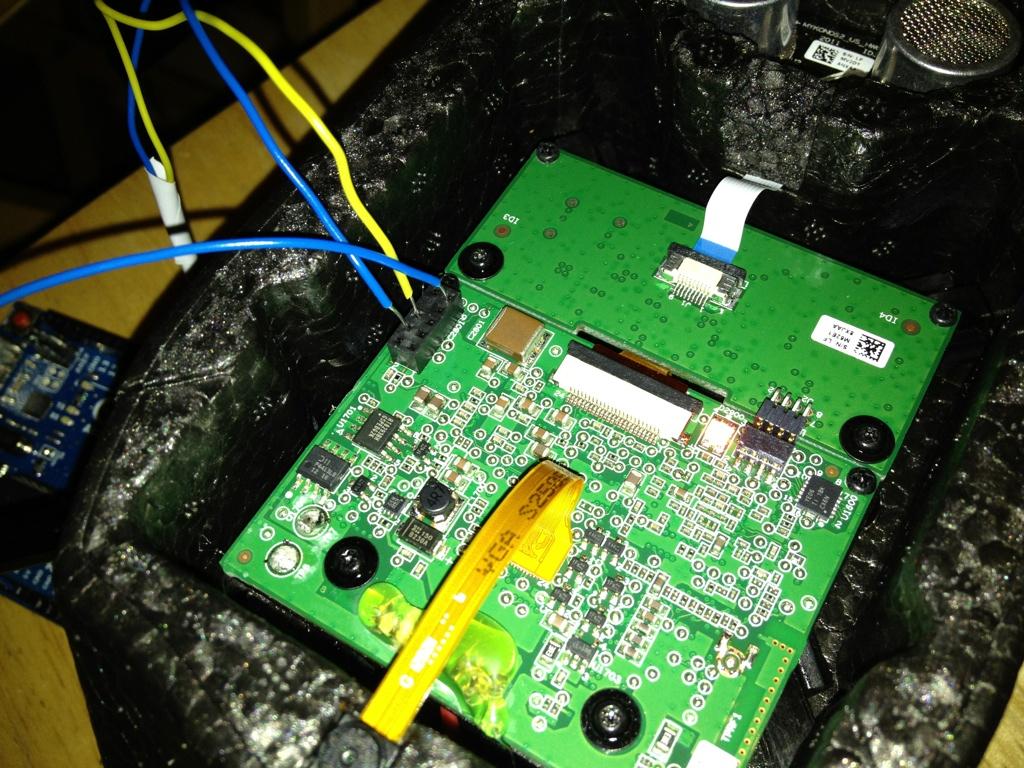- download node and node-serialport from https://github.com/felixge/node-cross-compiler/downloads
- untar node-serialport and put node and the node-serialport folder onto a usb thumbstick thingy
- put the thumbstick thingy into the drone (like in the above photo)
- telnet into drone,
telnet 192.168.1.1 cd /data/videocp usb/node .(it might be usb1)chmod +x nodemkdir node_modulescp -r usb/node-serialport/ node_modules/- note: you can use node-serialport to get data from arduino but you can't use johnny-five because it depends on firmata which doesn't support Tx/Rx serial communication
- this last point means you have to write actual arduino sketches and upload them to the arduino directly, but you can still write node code that runs on the drone to reads the serial data
- be very careful that you don't eff up your drone! proceed with caution
- the drone has a female USB port exposed next to the battery connector but unfortunately it is hardcoded into host mode so it can only be used with mass storage devices :(
- that last point is based on my naive understanding of electronics. prove me wrong and fork these instructions!
- there is another serial console on the drone motherboard
- open up the bottom of the drone under the little piece of black tape to expose a buncha plastic hole thingies:
- turns out this is a 3.3v TTL serial port. this awesome post by jazzomaniak is where I figured this out
- here is a pinout from jazzomaniak:
- you'll wanna get some thinnish gauge wire (around AWG 16 I reckon, AWG 22 is for most breadboards and my 22 wire didn't fit into the drone serial ports)
- get an arduino uno which provides 5v or 3.3v TTL serial via digital ports (Rx and Tx). due and uno have this, not sure about others
- hook up a wire from the Tx of the drone to the Rx of the arduino and Rx drone to Tx arduino. also hook up arduino GND to drone GND (#10)
- here is a shot from @rem of drone with the entire bottom cover removed
- you can also theoretically power the arduino from #8 and #9 on the drone if you hook them up to a barrel power jack thingy for the arduino (or use the Vin and GND pins for the same effect). I haven't hooked this up yet cause I ran out of cables. @rem in the comments below said he got it working
- you can also use the other USB port on the drone to power the arduino, but I don't have a short enough USB cable for this
- upload the sketch in this gist called
helloworld.pdeto the arduino - in a telnet shell on the drone type
cat /proc/cmdlineand find out whichttydevice the 'console' is set to. on my drone it wasttyO3 - set the tty socket to raw mode:
stty -F /dev/ttyO3 -raw - verify the baud rate of the socket:
stty -F /dev/ttyO3. mine originally said115200but after messing with it it seems to change to9600. the arduino sketch and the node code running on the drone need to both contain whateversttytells you the baud rate is for communication to work.
- the Input/output error above is because I was sending serial data from the arduino into the drone. I unplugged the serial cables from the arduino and tried the command again and it worked. I think it was around this time that the drone decided to switch baud rates to 9600
- go into a node repl (
./node) and copy paste inhelloworld.jsfrom this gist







